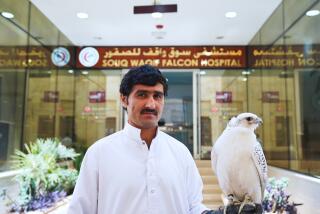‘Ships of Desert’ on Fast Track in Oman
- Share via
AL SEEB, Oman — “Hut, hut,” the young jockeys screeched, whipping their camels with bamboo sticks as Oman’s National Day races started with a dozen “ships of the desert” thundering off at a long-legged lope.
Trainers and relatives of the diminutive jockeys, 5 to 14 years old, roar down the side of the track in four-wheel-drive pickup trucks, screaming instructions, yelling at their riders.
Halfway down the 2-mile, arrow-straight track 25 miles west of the capital, Muscat, senior government officials and sheiks dressed in pristine white robes lounge in an open-sided tent sipping cardamom-scented Arabic coffee and iced soft drinks served on silver platters as the camels gallop past.
Betting Not Allowed
There is no betting. It’s forbidden in Islamic Oman. But there is prestige for the owners of winning camels, specially bred as racing steeds.
Camel racing, once little more than a desert pastime, has become a big sport in Oman and the other Arab states on the Persian Gulf, patronized by the region’s billionaire princes and sheiks. Racing camels sell for hundreds of thousands of dollars.
An Omani breeder, Saeed Malki, earlier this year sold a thoroughbred female racer to a sheik in the neighboring United Arab Emirates for a record $155,000.
Wealthy Arabs are spending millions of dollars in breeding racing camels and in prize money during the November-April season, when the searing desert temperatures cool to a tolerable 95 degrees.
Prizes Up to $250,000
Prizes can be as high as $250,000 in some of the bigger meets, particularly in the United Arab Emirates. In one race in Saudi Arabia recently, some 600 camels took part.
The sport has given camels a new lease on life. With the helter-skelter modernization brought by the Persian Gulf’s oil riches, camels have largely become obsolete as beasts of burden or transportation in a region where just about everyone drives a car or pickup.
Once camels were also the Bedouin nomads’ source of milk, hides and often food. But even this has disappeared as many desert dwellers moved to the towns. Some sheiks provide subsidies for camel breeders.
Oman’s National Day races don’t come near matching the Kentucky Derby.
The camels and their trainers, handlers and jockeys, who are dressed in ragged robes or colored track suits, squat in the sand at one end of the track, waiting their turn to race, hurling good-natured insults at each other.
Steward With a Dagger
A white-robed steward named Ahmad, curved Omani dagger in his ornate silver belt, tried to maintain order while keeping in touch with the finish line through a squawking walkie-talkie.
The runners are selected. The handlers strap in the boy jockeys behind the camels’ humps with cloth straps and Velcro pads so they won’t be hurled off.
The starter’s gun cracks and a dozen camels stampede from the starting line.
The handlers have to be agile to get out the way of the forest of hoofs. One middle-aged man was a little too slow and was trampled. Stunned and shaken, but apparently with no broken bones, he was carried to an ambulance.
More to Read
Sign up for The Wild
We’ll help you find the best places to hike, bike and run, as well as the perfect silent spots for meditation and yoga.
You may occasionally receive promotional content from the Los Angeles Times.






